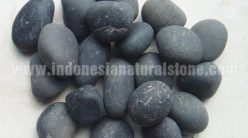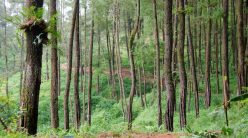Nok Aen
The Fifth Annual Dhamma-Yatra began yesterday (April 22) with a simple opening ceremony presided over by Phra Rajviraporn, the Lord of the Songkhla Sangha and active supporter of all the walks over the past five years. Thanks to local organizers, the ceremony was well attended by the local people around Wat Ban Poh (Khuan Piyaram), Pak Payoon district, Phattalung province. We were graciously hosted by Phrakru Nidesdhammadhaj, Abbot of Wat Ban Poh, and the members of his temple, including headmaster of the school across the street. Phrakru Nidesdhammadhaj also followed along this morning to insure that breakfast and lunch were ample and tasty. So, the 5th Dhamma-Yatra had a cordial start.
We actually began walking this morning (23rd) after reciting homage to the Buddha, Dhamma, and Sangha, and a short meditation session. Starting at about 6:15, we walked 3 kilometers to Wat Poh Riang at the edge of the Pak Payoon market. After breakfast, we walked through the Pak Payoon government offices and market and crossed a bridge onto Koh Maak. We were now within the middle lake. Throughout the morning, we walked along the west side of Koh Maak, just above the lake, through occasional rubber groves, a Pru swamp forest, and past a number of small villages displaying a level of wealth and consumerism much lower than is common in Thailand’s South. Most of the villages had mosques as Koh Maak’s population is 80% Muslim. We reached Wat Pakbang Nagaraj in time for lunch.
Edible Birds Nests:
Local people & Big Business Monopoly
[The combination of sound system and heavy rain made it difficult to hear. There may be some inaccuracies in the details. Although subsequent small discussions cleared up many questions, some details may still be inaccurate.]
In the afternoon, we had an open forum with local people about Nok Aen Kin Rang (edible nest swiftlets), their edible nests, and their politics and economics. The edible birds nests (EBNs) are a major export crop from this area. The first speaker was Dr. Kampol Meesawat from Prince of Songkhla University, an expert on Nok Aen. They like to live on the sheer faces and in the caves of Koh See Koh Haa (Four-Five Islands), the limestone islands to the north and west of Koh Maak. The nests are made from a saliva-like substance that the females produce, perhaps from their digested food. The main period for making their nests is January through March and each nest takes about one month. (Since the weather has been erratic this year, it isn’t known how their nest building has been effected.) It takes 3 weeks for the eggs to hatch and another 3 weeks for the nestlings to grow. The nests can be collected after this without seriously disturbing the birds.
If the first nests are removed before the eggs are laid, it takes the mother 20 days to make a second nest. However, this is such a strain on her that the nest is of poorer quality and has a reddish tinge. If these are harvested early, it takes the female only 15 days to make a third nest, which is of even poorer quality, not to mention a serious strain on the female. Although the male shares in child rearing duties, the females part will have been significantly compromised. Obviously, if the collectors are too greedy, they can pressure the birds to make 3 nests per season (year). This will increase the quantity of the nests and decrease their quality. It also oppresses the Nok Aen population. These birds were rare enough to begin with; they are only found in certain parts of Southeast Asia. They are now threatened and nominally protected in Thailand.
Sustainable collection means collecting once per year, after the first nest is no longer needed by the nestlings. This will insure that the Nok Aen population will be strong and the nests harvested will be beautiful and of high quality.
The second speaker was from the Local Administration Organization (LAO). He asked why the LAO can’t manage the edible birds nest harvesting themselves? Wouldn’t they get more of a profit for the local people by doing so?
The birds nests are given out as a concession to a single company —Rang Nok Laemthong Co. (Laemthong Birds Nests), an old Chinese family-owned, well-connected conglomerate. Laemthong guards Koh See Koh Haa strictly. Many people have been killed over the years. A few years ago, a whole boat load of “poachers” were found shot to death. Local people have no legal access to these small islands, although they can wade to them across the silted up lake bottom, and sightseeing boats have been chased away by armed guards. Laemthong has had the concession for as long as people can remember. However, most of the locals know little about the company, its owners, or their political connections.
As the discussion developed, the main question before the floor was how the birds nests can be harvested sustainably. A representative of the local people said the villagers are very concerned about the birds and their nests. The people have grown up seeing these birds flying back and forth from their island homes. In recent years, they see fewer Nok Aen flying around and fear that they are disappearing. They feel they can do a better job of caring for the birds and their habitat than Laemthong.
Further, the locals wonder why this public resource (lying exclusively when Koh Maak township) is under the control of one company and the local people have almost no say in the matter. Also, they want more of the taxes collected from the Birds Nests concession to be used for the benefit of the local people. So far, the LAO has put the tax money into building concrete roads around the island; improving schools, mosques, and temples; improving water systems and similar local “infrastructure projects.”
The Thai Rang Nok Laemthong Co. pays 350 million baht in taxes per year to the central government for its concessions in the 4 provinces in which Nok Aen produce edible nests. Of this, Phattalung province gets 100 million baht, which it disburses throughout the province. Last year, the Koh Maak LAO received 23 million baht to be shared among 9 villages and hopes to receive 30 million baht this year. If the Rang Nok Laemthong Co. is able to pay 350 million baht in taxes each year, what are their profits? 1 billion? 2 billion? Note that their concession requires very little investment and their product is sold in Singapore for 100,000 baht per kilogram ($1200 per pound) and around twice that in Los Angeles. Why do the local people receive less than 10% of the taxes, let alone the much larger amount that is the company’s profits? Is this Dhamma? Is this justice?
When somebody asked about how the nests are harvested, local people who knew replied that they can’t answer. Later, I was told that those who know can’t reveal it because of the reason they know. Since the company hires none of the locals, they could only know for harvesting the nests “illegally.” Obviously, they don’t want to reveal this in public. (The company only hires harvesters from elsewhere, claiming that locals could too easily steal nests.)
Laemthong also keeps its harvesting practices “secret.” However, this is less a “trade secret” than a cover-up. Their practice is to harvest the first nests early enough to pressure the Nok Aen to build second and third nests. This means that many Nok Aen eggs, and not a few live chicks, fall splattering on the rocks below. As mentioned above, this puts extreme pressure on the well-being of the females and contributes to their drop in population.
At the end, there were suggestions that concessions for harvesting edible birds nests be granted area by area instead of one concession for the whole country (actually just in the South). If the Koh Maak LAO and other LAOs in Nok Aen areas worked for this development, they would gain more influence over the process. Further, local cooperatives could get a foot in the door so that EBNs harvesting can be returned to the local people and be carried out sustainably.
For any of this to happen will require skilful politicking. All problems like this are inseparable from the corrupt money politics of the country. Further progress in democracy and Civil Society gives some hope of future resolution but the way will be long and difficult, and involve wrenching cultural disruptions.
However, it will be a long time before the ordinary villagers will have much control over any of this. Most likely, new concessions will be controlled by “local influential people” (often well connected politically, criminally, and ballistically). The whole thing could erupt in chaos and violent competition, with the bird population decimated. Therefore, any changes need to happen gradually. The Laemthong concession may not preserve the bird population very well, let alone share the profits fairly, but a sudden change of management would likely be even worse.
Many questions remain. It is almost always difficult to sort out the truth in situations involving conflict of interest, patriarchal government, old family businesses, and big profits. It is also difficult for outsiders to know how to help. Dhamma-Yatra continue to learn what we can and look for ways to help. We try to bring Dhammic perspectives into these messy and potentially violent situations. The walk through samsara appears likely to carry on for a long time.
Some Dhammic reflections on the Nok Aen situation
In reporting about the Nok Aen problems around Koh Maak, I didn’t have time to include Dhammic reflections on the situation. Nonetheless, at the end of the discussion at Wat Pakbang Nagaraj, I was asked to do just that. Let me share a few perspectives. More will develop with further bulletins.
Gratitude is a fundamental value in Thai Buddhism. From infancy, Thais are taught to feel gratitude to the Triple Gem (Buddha, Dhamma, & Sangha), to parents & ancestors, and to teachers. This is stressed at home, temple, & school. At least in the villages … Older elements in the culture, going back to spirit-based beliefs & traditions, feel the same gratitude towards nature, towards the fields, streams, rivers, forests, swamps, hills, and seas that feed & cloth us, and provide shelter & medicine. Today, many monks extend the notion of “ancestors” to the natural environment that gives us life. In all cases, gratitude is considered the appropriate response: the knowledge that we have benefited from others (kataññu), the feeling (katavedi), and appropriate actions.
The behavior of the Laemthong Co., their cohorts in the government, and local politicians seeking their share of the loot, show a profound disregard for the value of gratitude. What gratitude their class reveals is generally the self-serving showy version reserved for state functions, staged charity events, and other displays that do little good for the people and country as a whole. Duplicitously, the illusion plays on in a culture where “face” is more important than truth.
The basic precepts of non-harming and non-stealing are well established in the minds of ordinary Thais. In the past, popular wisdom imbedded basic Buddhist morality within village culture. For example, it was accepted that killing fish was a “sin,” but that doing so to feed the family could be redeemed by doing good (making merit), such as sharing a portion of the food with the temple. However, large-scale killing for the sake of commerce and profit was considered serious bad kamma that would stick with one into future lives. Needless to say, the elites, under “modern” influences (beginning in the early 1800s), have used the education system and media to disparage such values and replace them with more profit and wealth accumulation values. (More on this in later bulletins.)
Clearly, Laemthong’s concession, the way it is operated by them, and the way it is administered by the government consistently break these basic precepts. The Nok Aen population — countless birds, chicks, and eggs — are harmed most directly, along with their habitat. The violence of the company’s guards against local people is also quite direct. Finally, principles enshrined in the new constitution stipulate the right of local people to usage and oversight of local resources. That this is denied the people of Koh Maak amounts to corporate and government theft.
Underlying the precepts is the most fundamental principle of all, the inter-relatedness of all life. Implicit in our mutual dependence is the responsibility of mutual support. While no society may ever know a total lack of exploitation and violence, when these are kept to a relative minimum — relative to the needs of a healthy society — a society maintains itself creatively, justly, peacefully, with the needs of all members taken care of, and without shifting the burden to other societies or the environment. When, however, certain sectors of a society, especially its elites, show little genuine concern for the needs of the majority, let alone the less privileged members, that society will enter a downward spiral of violence, dishonesty, and decay in which its survival is at risk. Thailand has entered this downward spiral in a big way.
These perspectives also apply to most of the situations and controversies we will see. Therefore, these reflections will be continued in upcoming bulletins.
[It may not be possible to give detailed reports on each day. However, I will try to cover the 3 or 4 “hot issues” we expect to meet. In addition to the Nok Aen nests, the other issues are the Anchovy controversy (27th), the proposed dam across the lake (May 2nd), and the petrochemical complex conflicts (May 5th).]
Thank you for your interest. Feel free to share these bulletins as widely as you like. Fax, reproduce, email, and publish them as much as you want. Please do not edit them in any way that changes the meaning or intent of the author, and accredit them to Santikaro Bhikkhu on behalf of “The Dhamma-Yatra for Songkhla Lake” © 2000.





